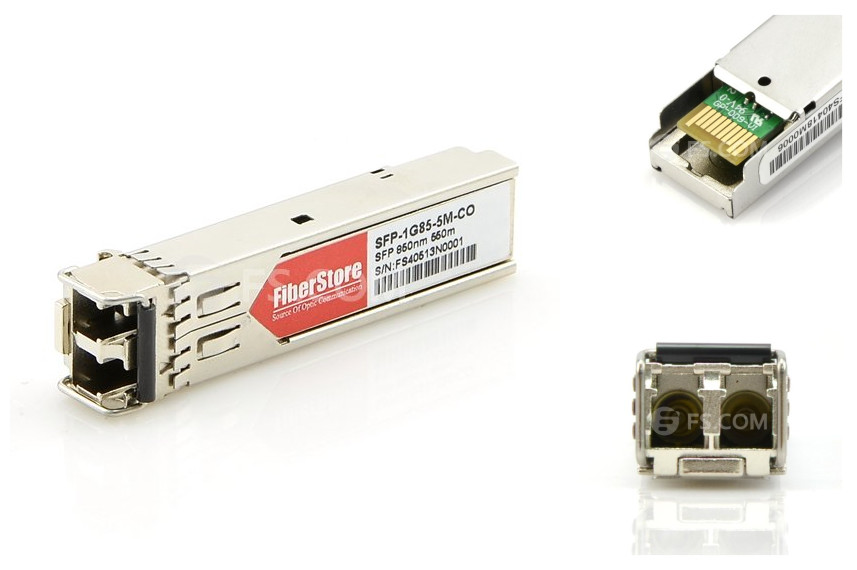June 06, 2016
Optical transceiver module is a device which can transmit and receive light and electrical signals in fiber optic networks. An optical transceiver generally has two ports, one for converting electrical signal into light signal and the other for changing light signal into electrical signal. Based on different data rates, there are many different kinds of transceiver modules, such as SFP (small form-factor pluggable), SFP+ (small form-factor pluggable plus), QSFP+ (quad small form-factor pluggable plus), CFP (C form-factor pluggable). Among them, SFP optical transceiver is a compact and hot-pluggable transceiver widely deployed for the Fast Ethernet and Gigabit Ethernet, for example, Cisco GLC-SX-MM compatible 1000BASE-SX SFP transceiver, as shown below, can support data rate up to 1000Mbps. In this post, a brief introduction to several commonly used SFP transceivers will be given.

Coarse wavelength division multiplexing (CWDM) SFP is made up of three parts: an uncooled laser transmitter, a PIN photodiode integrated with a trans-impedance preamplifier and a MCU control unit. It is an economical technique to save fiber resources through transmitting multiple wavelengths on one optic fiber. CWDM SFP is a kind of single-mode transceiver used for Gigabit Ethernet and Fibre Channel applications. The wavelengths of CWDM SFP are between 1470nm and 1610nm distinguished by different colors. Most commonly used CWDM SFP transceivers include CWDM SFP 1470, CWDM SFP 1490, CWDM SFP 1510, CWDM SFP 1530, CWDM SFP 1550, CWDM SFP 1570, CWDM SFP 1590, and CWDM SFP 1610, etc. CWDM SFP can support high performance of 1.25Gbps data rate and 80km transmission distance.
Dense wavelength division multiplexing (DWDM) SFP is a type of hot-pluggable transceiver used for Gigabit Ethernet which gathers different wavelengths onto one single fiber. Compared with CWDM SFP, DWDM SFP has a more intensive wave spacing for a high performance of data communication. The working wavelength of DWDM SFP ranges from 1525nm to 1565nm or 1570nm to 1610nm. The wave intervals are varied in 0.4 nm, 0.8 nm, 1.6 nm, etc. And the port of DWDM SFP transceiver uses SFP interface for over 1 gigabit optical data transmission.
BiDi SFP is short for Bi-Directional SFP. The core technology of BiDi SFP transceiver is the BiDi technique which enables bidirectional transmission of two different waves. BiDi module has only one port, and it must be deployed in pairs. For example, when a BiDi SFP module is used for receiving 1310nm and transmitting 1550nm optical signals, the other should receive 1550nm and transmit 1310nm signals, and vice versa. BiDi SFP transceiver usually costs twice the price of common SFP transceivers, but it is a better way to save the expenditure spent on optical fiber. BiDi transceivers have the advantage of reducing fiber cabling infrastructure costs by lowering the number of fiber patch panel ports, decreasing the amount of tray space dedicated to fiber management, and using less fiber cable.
Fibre Channel (FC) SFP uses the technology of fiber channel for high speed optical signal transmission with a data rate up to 4.25 Gbps. Fiber channel is a mature technology for serial interface standardized by American National Standards Institute (ANSI). It is applied to the connection between the storage controller and computer drivers. Nowadays, FC has played as a replacement for the Small Computer System Interface (SCSI) in high-performance storage systems, because fiber channel is faster in transmission speed and more flexible in the transmitting mode with or without fiber in accordance with the transmission range.
Synchronous optical networking (SONET) SFP or synchronous digital hierarchy (SDH) SFP is a kind of transceiver based on the SONET/SDH standard. SONET/SDH is the physical standard for fiber optic transmission, first brought out by Bellcore in 1980s and then standardized by American National Standards Institute (ANSI) for popularization all over the world. SONET/SDH standard mainly stipulates the transmission rate, fiber interface, operation and maintenance in optical fiber transmission. SONET/SDH SFP transceivers can support OC-3 (up to 155.52 Mbps), OC-12 (up to 622.08 Mbps), and OC-48 (up to 2488.32 Mbps) data rates for multimode, short-reach, intermediate-reach, and long-reach applications.
SFP modules are found in Ethernet switches, routers, firewalls and network interface cards. With advantages of low cost, low profile, and the ability to provide a connection to different types of optical fiber, SFP modules provide the related equipment with enhanced flexibility. SFP transceivers are hot-pluggable small form factors used for 100BASE and 1000BASE Ethernet data transmission. There are different types of SFP modules, including BiDi SFP, CWDM SFP, DWDM SFP, SONET/SDH SFP and FC SFP. Each of them supports different techniques, which brings convenience to data communication.
Posted by: jowang at
03:29 AM
| No Comments
| Add Comment
Post contains 769 words, total size 6 kb.
35 queries taking 0.0292 seconds, 70 records returned.
Powered by Minx 1.1.6c-pink.









